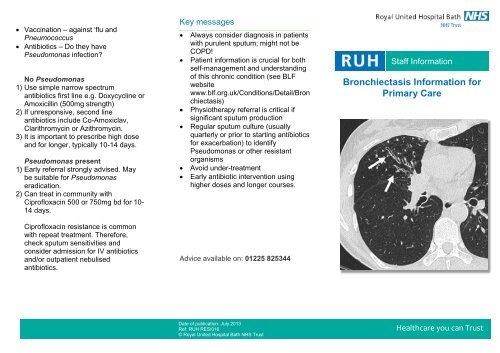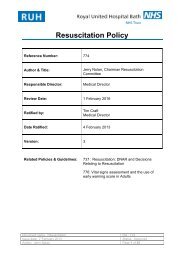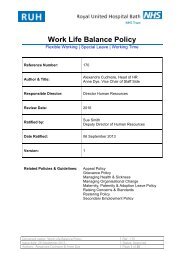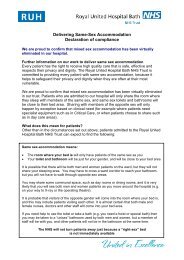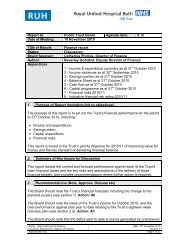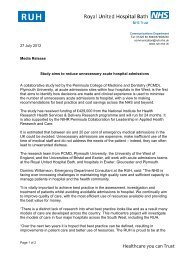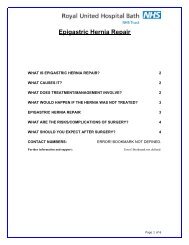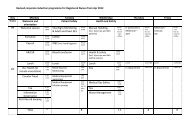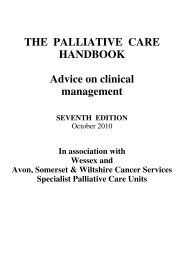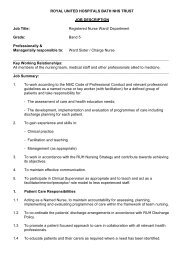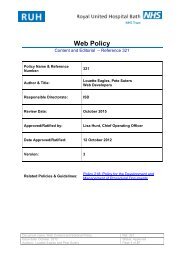Bronchiectasis Information for Primary Care - Royal United Hospital ...
Bronchiectasis Information for Primary Care - Royal United Hospital ...
Bronchiectasis Information for Primary Care - Royal United Hospital ...
You also want an ePaper? Increase the reach of your titles
YUMPU automatically turns print PDFs into web optimized ePapers that Google loves.
Vaccination – against „flu and<br />
Pneumococcus<br />
Antibiotics – Do they have<br />
Pseudomonas infection?<br />
No Pseudomonas<br />
1) Use simple narrow spectrum<br />
antibiotics first line e.g. Doxycycline or<br />
Amoxicillin (500mg strength)<br />
2) If unresponsive, second line<br />
antibiotics include Co-Amoxiclav,<br />
Clarithromycin or Azithromycin.<br />
3) It is important to prescribe high dose<br />
and <strong>for</strong> longer, typically 10-14 days.<br />
Pseudomonas present<br />
1) Early referral strongly advised. May<br />
be suitable <strong>for</strong> Pseudomonas<br />
eradication.<br />
2) Can treat in community with<br />
Ciprofloxacin 500 or 750mg bd <strong>for</strong> 10-<br />
14 days.<br />
Ciprofloxacin resistance is common<br />
with repeat treatment. There<strong>for</strong>e,<br />
check sputum sensitivities and<br />
consider admission <strong>for</strong> IV antibiotics<br />
and/or outpatient nebulised<br />
antibiotics.<br />
Key messages<br />
<br />
<br />
<br />
<br />
<br />
<br />
Always consider diagnosis in patients<br />
with purulent sputum; might not be<br />
COPD!<br />
Patient in<strong>for</strong>mation is crucial <strong>for</strong> both<br />
self-management and understanding<br />
of this chronic condition (see BLF<br />
website<br />
www.blf.org.uk/Conditions/Detail/Bron<br />
chiectasis)<br />
Physiotherapy referral is critical if<br />
significant sputum production<br />
Regular sputum culture (usually<br />
quarterly or prior to starting antibiotics<br />
<strong>for</strong> exacerbation) to identify<br />
Pseudomonas or other resistant<br />
organisms<br />
Avoid under-treatment<br />
Early antibiotic intervention using<br />
higher doses and longer courses.<br />
Advice available on: 01225 825344<br />
Staff <strong>In<strong>for</strong>mation</strong><br />
<strong>Bronchiectasis</strong> <strong>In<strong>for</strong>mation</strong> <strong>for</strong><br />
<strong>Primary</strong> <strong>Care</strong><br />
Date of publication: July 2013<br />
Ref: RUH RES/016<br />
© <strong>Royal</strong> <strong>United</strong> <strong>Hospital</strong> Bath NHS Trust<br />
Healthcare you can Trust
Definition of <strong>Bronchiectasis</strong><br />
Dilatation of the bronchi usually<br />
associated with chronic purulent sputum<br />
punctuated by exacerbations.<br />
Clinical features<br />
Chronic cough, often with copious foulsmelling<br />
purulent sputum. There may also<br />
be shortness of breath, wheeze and<br />
haemoptysis.<br />
Pathology<br />
The dilated bronchi may be associated<br />
with ciliary damage (poor sputum<br />
clearance), fibrosis and saccules with<br />
progressive lung damage as a<br />
consequence of chronic infection.<br />
Causes<br />
The commonest cause is previous<br />
infection, often childhood pneumonia<br />
following whooping cough or a viral<br />
pneumonitis. However, there are other key<br />
causes including: cystic fibrosis, previous<br />
TB, hypogammaglobulinaemia (low IgG)<br />
and rheumatoid disease.<br />
<br />
<br />
<br />
<br />
<br />
Symptoms<br />
Cough – may be intermittent or<br />
continuous, dry or productive<br />
Sputum – may be clear, purulent or bloodstained<br />
(or just blood)<br />
Breathlessness – may be absent, mild<br />
increasing to very severe<br />
Exacerbations – may be occasional or<br />
very frequent. An exacerbation might<br />
present with a relatively minor change in<br />
sputum purulence, volume or viscosity, or<br />
haemoptysis. Always consider<br />
bronchiectasis in the patient who requires<br />
numerous courses of antibiotics <strong>for</strong><br />
recurrent „chest infections‟<br />
Fatigue and weight loss.<br />
Signs<br />
There may be none! But you may hear<br />
crackles and wheezing. Other possible<br />
features include clubbing and pulmonary<br />
hypertension.<br />
Investigations<br />
Sputum culture:<br />
This is invaluable when considering<br />
treatment. Give clinical details as<br />
<br />
<br />
<br />
<br />
<br />
<br />
<br />
“<strong>Bronchiectasis</strong> sputum” to guide<br />
microbiology to test <strong>for</strong> Pseudomonas and<br />
less common organisms. It is sensible to<br />
ask specifically <strong>for</strong> „AFB‟, on two<br />
occasions <strong>for</strong> those with moderate to<br />
severe bronchiectasis in order to identify<br />
possible non-tuberculous mycobacteria<br />
(NTM).<br />
Chest x-ray – often normal<br />
HRCT chest – the best imaging but rarely<br />
need to repeat if bronchiectasis already<br />
confirmed<br />
Spirometry – often see obstructive picture<br />
similar to COPD<br />
Bloods – immunoglobulins including IgE<br />
(Aspergillus IgE if patient has asthma).<br />
Autoimmune profile including rheumatoid<br />
factor. Alpha-1 antitrypsin levels. In<br />
hospital - will need sweat test/CF genome<br />
analysis if


